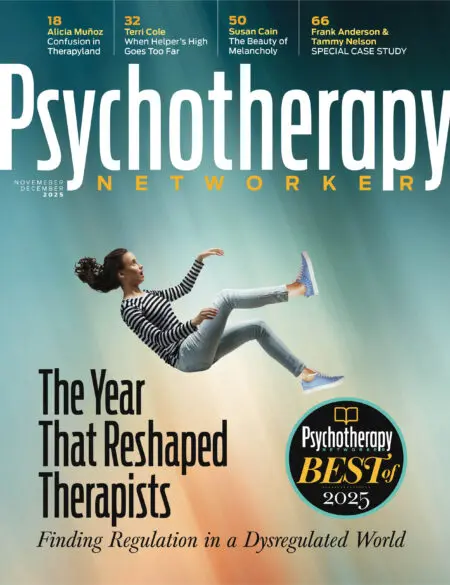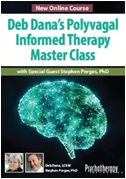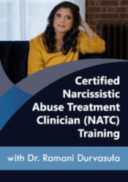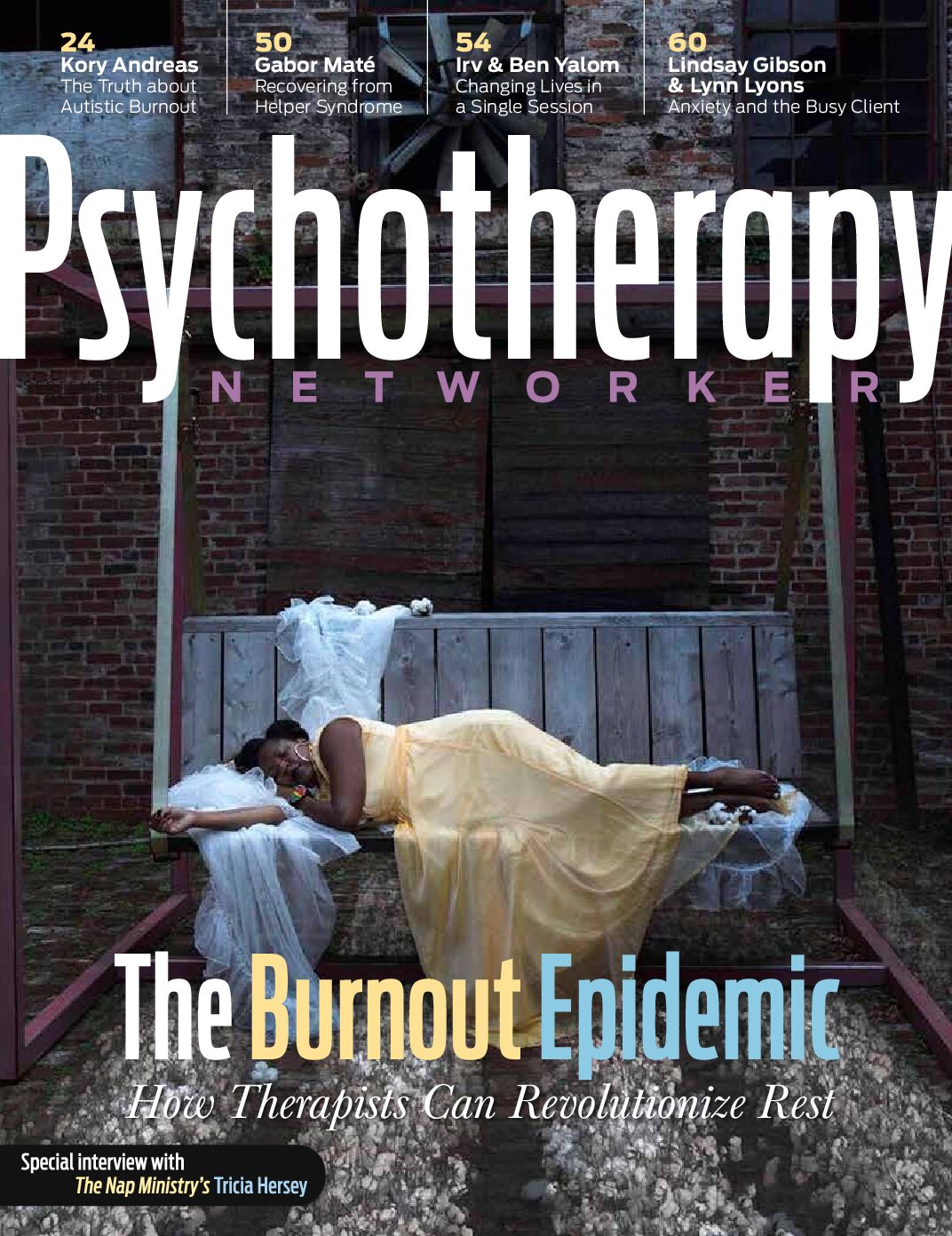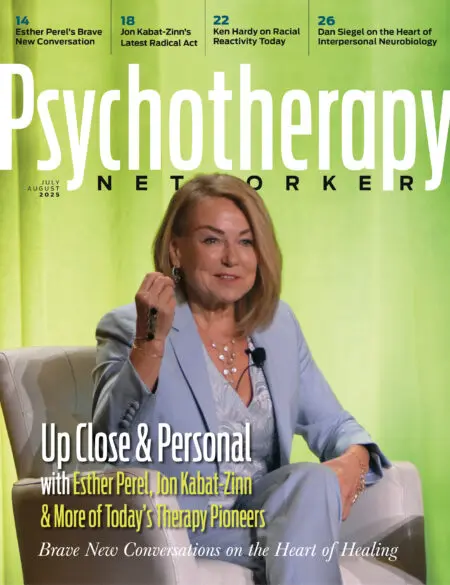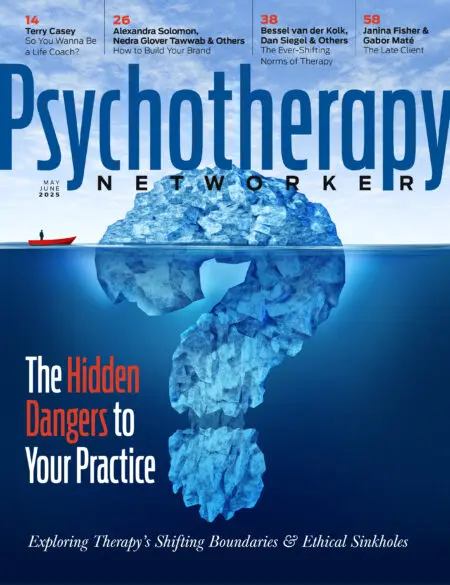Five hundred people sat in a packed workshop at the Networker Symposium last March, listening to eminent developmental psychologist and researcher Jerome Kagan draw on more than four decades of research he’s conducted as he discussed the clinical relevance of inborn temperament. Midway through the session, responding to a question from the audience, he tried to clarify an earlier, seemingly disparaging, comment he’d made about attachment theory. But he soon removed any possible doubt about where he stood. “I’m glad that attachment theory is dead,” he said. “I never thought it would go anywhere.”
There was a moment of stunned silence, followed by a low hum as people shifted in their seats and murmured to each other. Whatever their imperfect understanding of the voluminous research literature of attachment theory, for most therapists in the room, the idea that the early emotional attunement of a mother/caregiver (or lack of it) profoundly affects the child’s psychological development was as self-evident as the worthiness of therapy itself. Indeed, during the last 15 to 20 years, attachment theory has exerted more influence in the field of psychotherapy than just about any other model, approach, or movement. Though not a clinical methodology, it has justified a whole range of therapeutic perspectives and practices. Among them are a particular sensitivity to the role of traumatic or neglectful ties with early caregivers; the fundamental importance of affect regulation to successful therapy; the importance of establishing relationships with clients characterized by close, intense, emotional, and physical attunement; and the ultimate goal of recreating in therapy an attachment experience that makes up, at least to some degree, for what the client missed the first time around. That attachment theory itself has amassed a vast body of empirical evidence (see p.34) is often taken, by extension, to cast a glow of scientific credibility on attachment-based therapy. So when Kagan delivered his offhand rebuke, he was raising fundamental questions about the evidence supporting findings that most therapists there considered not just theory, but well-established fact.
Suddenly, in the wordless void that followed Kagan’s bombshell, psychiatrist, brain researcher, and staunch attachment theory proponent Daniel Siegel popped out of his seat, looked for a floor microphone to respond, and, finding none, strode up the center aisle and bounded onto the stage. As a startled Kagan looked on and the entire ballroom audience sat dumbfounded, Siegel, the conference keynote speaker from that morning, asked for a microphone and announced: “I can’t let this audience listen to your argument without hearing the other side. Have you actually read the attachment research?” he demanded of his colleague.
There followed a heated, impromptu debate between the two men that later became the talk of the conference. Part of the buzz was because it was a disagreement between two stars—Jerome Kagan, arguably the most revered developmental psychologist in the world, and Daniel Siegel, one of the most influential thinkers and teachers in the field of psychotherapy today. Each brought to bear both an impressive resume and passionately held convictions on the age-old question about human development: which counts more—nature or nurture? Beyond its sheer drama, two things stood out about this spontaneous encounter—the surprise that a discussion of research findings could generate such intellectual fervor at a psychotherapy conference and, for the majority of the audience, the shock that there was any debate at all about the role of early experience in human development. It was as if a leading biologist had gotten up at a professional conference to denounce germ theory.
In the world of psychotherapy, few models of human development have attracted more acceptance and respect in recent years than the centrality of early bonding experiences to adult psychological well-being. Nevertheless, the Kagan–Siegel encounter brought to the surface a barely visible fault line between true believers in attachment and its doubters, who not only question the idea that the quality of the mother-child attachment always and permanently affects a child’s psychological development, but whether attachment theory itself has had a positive or negative influence on the practice of psychotherapy. It raised the question of whether the growing centrality of attachment theory has begun to blind the field to other vital influences on a person’s development—inborn temperament, individuation needs, family dynamics, even class and culture—which all lie outside the mother–child dyad.
But what on earth could ever be wrong with emphasizing early bonding, connection, and relationship as the foundation of all good therapy? Are there ever times when too much “attunement” and “empathy” can constrict a therapist’s clinical repertoire and obfuscate the issues with which clients should deal? For those for whom this debate focuses on a theory that wasn’t even on their grad-school curriculum, what’s all the fuss about, and what exactly does attachment theory tell us that we haven’t known since the days of Freudian analysis?
The Ascent of Attachment Theory
In the 1970s and early ’80s, the groundbreaking innovations influencing clinical practice came not from the attachment literature, but from the iconoclastic rebels promulgating the gospel of family systems theory. Figures like Salvador Minuchin, Murray Bowen, Jay Haley, Virginia Satir, and Carl Whitaker became the role models for a generation of clinicians, followed during the ’80s by more schematic, minimalist, and pragmatic therapies, like brief solution-focused therapy and Cognitive-Behavioral Therapy. As the quiet, blank-screen demeanor of psychoanalysts eternally waiting for their clients to gain insight became passé, what united the new generation of innovators, whether the whirling dervishes of family therapy or the mild-mannered, systematic interviewers of solution-oriented work, was a focus, not on the ancient past, but on what they could make happen in sessions right then.
In those days, attachment theorist John Bowlby’s name or work was seldom mentioned in clinical circles; much less did it appear on any training curriculum. Nevertheless, Bowlby had been developing his theory for decades. Even before training as a psychiatrist, he did volunteer work at a residential school for maladjusted and delinquent children, concluding that the complex behavior of these children—not only their delinquency, but their anger, unpredictability, and rejection even of those who tried to befriend them—was directly related to their early emotional deprivation. As a young psychiatrist, he believed that psychoanalysis emphasized the child’s fantasy world too much and what actually transpired in the child’s everyday life too little. The prevailing assumption, for example, was that the child’s bond with the mother was based on the association of mom with food—kids missed the breast, not the breast’s owner. It was what Bowlby waggishly referred to as the “cupboard love theory of infant love.”
In 1944, he prepared what would become a classic paper, “Forty-Four Juvenile Thieves, Their Characters and Home Lives,” based on case notes made during a stint at the London’s Child Guidance Clinic, in which he determined that the children who habitually stole had suffered the most maternal deprivation—most of them institutionalized or hospitalized for much of their early years and rarely visited by family. Emotionally damaged and undemonstrative, they felt no affection for anybody, demonstrated no sense of shame or responsibility, and were, in effect, young psychopaths. After the war, he went to work at the Tavistock Clinic to head the Children’s Department, which he promptly renamed The Department for Children and Parents—to highlight his belief that parent–child interactions were critical to the child’s development.
His work on delinquents brought him to the attention of the World Health Organization, which asked him to prepare a report on the mental health of the hundreds of thousands of children rendered homeless by World War II. Titled Maternal Care and Mental Health, it drew on interviews with child psychiatrists, pediatricians, and social workers in Europe and America who actually worked with homeless children (unlike the methodology of most analysts or learning theory researchers, who largely rejected Bowlby’s conclusions). Through the preparation of this report, Bowlby came up with what would be his lifetime thesis: the loss of a mother figure at a vulnerable age was far more distressing and potentially psychologically damaging than previously recognized. “The young child’s hunger for his mother’s love and presence,” Bowlby and his colleagues suggested, “is as great as his hunger for food.” Its absence “generates a powerful sense of loss and anger.” Furthermore, Bowlby, et al., continued, the “responses and processes” seen in these children deprived of their primary caregivers “are the very same as are known to be active in older individuals who are still disturbed by separations that they suffered in early life.”
By this time, Bowlby’s research was convincing him that humans developed not as individual monads, struggling against their own aggressive impulses toward civilization—the psychoanalytic view—but as members of interacting systems. The human infant didn’t, in fact, yearn for “the breast,” as child psychologist Melanie Klein had it, but for the one and only human being whose breast it was. “This profound attachment to a particular person,” wrote Bowlby in 1956, “is both as strong as, and often as irrational as, falling in love, and the very similarity of these two processes suggest strongly that they may have something in common.” Finally, the source of psychopathology wasn’t to be found in internalized Oedipal conflicts, but in failed or unavailable infant and early childhood attachments.
Bowlby’s work was greeted by his psychoanalytic colleagues with a mix of indifference and hostility, which would last until roughly 1980. Even Bowlby’s own analyst opposed his ideas. “Psychoanalysis,” she wrote, “is not concerned with the real world. . . . It is concerned simply and solely with the imaginings of the childish mind.” Psychoanalyst Anna Freud reacted similarly, arguing that psychoanalysis doesn’t “deal with the happenings in the external world as such but with their repercussions in the mind.” Even pediatrician and psychoanalyst D. W. Winnicott, with his “holding environment” and the “good enough mother”—concepts that seemed to have affinity with Bowlby’s ideas—said once, “I can’t quite make out why it is that Bowlby’s papers are building up in me a kind of revulsion.” Actually, the reason for Winnicott’s “revulsion” seems obvious: Bowlby’s ideas threatened the whole edifice of orthodox psychoanalysis. Winnicott himself admitted in his comments about one of Bowlby’s papers that “It was certainly a difficult paper to appreciate without giving away everything that has been fought for by Freud.”
Meanwhile, supported or not by the establishment, Bowlby was gathering his own troops together to develop a full-fledged theory of attachment and loss. He wanted to know what the process of normal and abnormal attachment looked like—what actually happened, moment by moment, between mother and child—so he could explore how it affected emotional development. Probably his most famous colleague was American developmental psychologist Mary Ainsworth, who studied with him at Tavistock, then spent two years in Uganda researching mother–child interactions. Returning to America, and taking a teaching job at Johns Hopkins University, she documented thousands of hours of home observations of mother–child behavior.
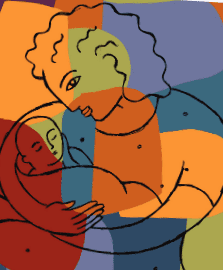
As a long-distance colleague of Bowlby’s, during the 1960s, she devised the Strange Situation experiments, based on his principles, which documented a series of separations and reunions between mothers and their very young children in a controlled setting (see p. 31). Drawing inferences about the quality of mother–child attachment from these experiments, Ainsworth concluded that there were three types of attachment relationships: secure, insecure-avoidant, and insecure-ambivalent.
Over the next decade or so, Ainsworth worked through the statistical analysis of her observations, painstakingly trained a cadre of other researchers in these methods, and finally completed her book Patterns of Attachment in 1978. But the word gradually spread through the research community that this research was a game-changer. The Strange Situation experiments, based as they were on exhaustive buttressing research (between 66 and 80 hours of observation of each mother–child dyad over the year prior to the experiment), for the first time provided empirical evidence for what had been purely an intuitive belief in the emotional significance of the mother–child bond. While child cognition had been studied exhaustively, emotion hadn’t.
The Strange Situation became the most widely used standardized way of measuring what never before had been measured—the subtle, elusive quality of the shifting emotions between a mother and child over the course of a short period of time. Moreover, the observations made by Ainsworth and her colleagues demonstrated that infants weren’t passive recipients of oral gratification—the Freudian view—but actively sought contact with their mothers and vigorously protested when it was denied. The mother–child dyad was very definitely a two-person, emotionally resonant relationship.
Through the years, attachment theory began to acquire converts, at least among developmental psychology researchers. Between 1969 and 1980, John Bowlby, bringing together both older research on infants and the growing body of attachment research, published his “Attachment and Loss” trilogy, now considered a classic: Attachment; Separation: Anxiety and Anger; and Loss: Sadness and Depression. The first book, Attachment, was received poorly by the usual psychoanalytic suspects, but 11 years later, when Loss was published, Bowlby—who’d spent two decades as persona non grata in analytic circles—was being “rehabilitated.” During the ’80s, he was actually appointed the Freud Memorial Professor of Psychoanalysis at University College in London. Attachment research was becoming respectable.
Still, clinical professionals remained largely uninvolved and unmoved until at least the early 1990s. A client’s early childhood relationship with a primary caregiver was largely a matter of indifference for therapists who were purveying the popular brief, pragmatic approaches with short-term, problem-solving goals. Academic psychiatrists of the day were increasingly oriented toward single-minded psychopharmaceutical approaches, and many psychoanalytic holdouts remained true to their orthodox roots, while behaviorists had never paid much attention to emotion, much less attachment angst.
Certainly psychodynamic therapists understood the enduring impact of childhood experiences, but even if they’d been fascinated by attachment studies, it was still an open question how these early mother–child bonds might play out in adult psychopathology. From early in his career, Bowlby was convinced that childhood attachment patterns—good or bad—could have a profound impact on a person’s psychological development and capacity for intimate relationships throughout life. The question was how did this happen. “How does it come about that one or another of the events included under the general heading of maternal deprivation produces this or that form of psychiatric disturbance?” he wrote in the preface to Attachment. “What are the processes at work? Why should things happen this way?” The next, obvious question was how these attachment processes in young children somehow leaped ahead over the years, influencing and even predicting adult behavior.
Beginning in the 1970s and throughout the ’80s, Mary Main, a protégé of Ainsworth and research psychologist at the University of California, Berkeley, began interviewing parents and studying their interactions with their babies. They found that attachment rejection or trauma in a mother’s childhood was systematically related to the same sort of attachment issues between her and her child. From this kind of research, Main and her colleagues devised an interview method—the Adult Attachment Interview (AAI). It contained 20 open-ended questions about people’s recollections of their own childhood, for example: Describe your relationship with your parents. Think of five adjectives that reflect your relationship with your mother. What’s the first time you remember being separated from your parents? Did you ever feel rejected? Did you experience the loss of someone close to you? How do you think your experience affected your adult personality?
More important than the specific content gathered from the interview—which could be more or less accurate—was the way people responded. Whether their personal narratives were coherent or confused, whether they dismissed the questions with short, uninformative answers, or rambled on pointlessly, for example, provided real—and ultimately, empirically validated—insights about their state of mind, emotional processes, and capacity to form relationships. Main’s goal, she said, was to “surprise the unconscious” into revealing itself. Furthermore, the interview has, over the years of repeated use, been found capable of targeting, with more than 80-percent predictability, how a child of the adult interviewee would be attached to his/her parent. While other variants of adult attachment measures have been developed, the AAI set the stage for an empirically validated way of following the transmission of attachment patterns from generation to generation—documenting a kind of psychic lineage from parent to child to grandchild. In fact, according to psychology researchers Howard and Miriam Steele in Clinical Applications of the Adult Attachment Interview, the AAI was “the single most important development in attachment research over the last 25 years.”
By the mid-1980s, “attachment labs” had sprung up around the United States—at the State University of New York at Stony Brook, the University of California, Davis and Berkeley, and the University of Minnesota, among others. There, social and developmental research psychologists not only observed mothers and babies, but began to study the long-term effects of secure and insecure attachment on adolescents and adults. As children who’d undergone the Strange Situation experiment grew up, they were studied to determine the continuity of early attachment patterns in their development. The University of Minnesota’s Institute of Child Development, led by Alan Sroufe, has been running a longitudinal study of parents and children since 1976, focusing on the role of attachment and other issues on individual development (see p. 38).
Clinical Applications
It was one thing to provide a theoretical explanation of people’s unhappy attachment experiences; it was another to develop therapeutic approaches by which clients could get beyond the limits of those early experiences. Bowlby himself, never an early-attachment determinist (he believed that it was never too late to change), thought that a therapist could provide what the parents hadn’t—a safe, dependable, empathetic, and attuned presence that would enable the client to do some of the “growing up” he/she couldn’t afford to do in the unsafe early environment. Attachment theory seemed to suggest that what mattered most in this clinical relationship was the therapist’s capacity for emotional attunement—the ability to hear, see, sense, interpret, and respond to the client’s verbal and nonverbal cues in a way that communicated to the client that he/she was genuinely seen, felt, and understood. Attachment research had emphasized the psychobiological core of attunement between mother and child—the continual, subtle, body-based, interactive exchange of looks, vocalizations, body language, eye contact, and speech. Attunement—or “contingent communication,” as Daniel Siegel coined it—was really a highly complex, supremely delicate, interpersonal dance between two biological/psychological systems. If this contingent communication was a characteristic of healthy attachments between parent and child, or between husband and wife, or friend and friend, then wasn’t it also critical to good therapy?
Of course, the idea that therapists should establish a close, empathic bond with clients—provide “unconditional positive regard” and a “corrective emotional experience” for clients—was old hat, at least for psychodynamic therapists. But at a time when brief, technical, pragmatic therapies were all the rage, attachment research seemed to offer genuine scientific validation for a deeper, emotion-focused approach that took infancy and early childhood seriously. The rich, evocative descriptions of attachment theory, the basic allure of it (what could be more appealing, more psychologically nourishing, than mother-love?), the very fact that such a pretty package was gaining scientific heft made it almost irresistible to many therapists. While attachment theory in itself didn’t provide an accompanying toolbox of tactics and techniques, it did offer a new therapeutic attitude, justifying deep, soul-felt work, which would offer the client a genuinely new beginning.
Even so, it’s still possible that attachment theory wouldn’t have “caught on” if a virtual revolution in brain science hadn’t happened at the same time. Bowlby always believed that attachment was biologically necessary in itself for survival. Looking at attachment through the lens of neuroscience from the late ’80s to the present, researchers found that the mother–child bond, in effect, began to knit together the neural filaments of the newly emerging baby-brain—literally altering both the structure and activity of neural connections. In 1994, UCLA psychology researcher and therapist Allan Schore explained in his multidisciplinary book, Affect Regulation and the Origin of the Self, how the back-and-forth interaction between parent and infant regulates the swirling sea of intense, turbulent emotions registering in the baby’s brain. In the process, the attuned parent is actually helping the baby begin to develop the neurological capacity to regulate his/her own emotions.
Schore’s synthesis comprised a psychoneurobiological theory of human emotional development from infancy. The book wasn’t about psychotherapy, per se, but he did discuss certain serious clinical issues that originated in poor early attachment—personality disorders, for instance. He quoted UCLA psychiatry professor and psychoanalyst James Grotstein, writing in 1986, that “All psychopathology constitutes primary or secondary disorders of bonding or attachment and manifests itself as disorders of self- and/or interactional regulation.” Putting it crudely, the insecurely attached infant never got the maternal neural imprinting that would help her learn to regulate her own nervous system, thus making her susceptible to uncontrollable storms of inconvenient and unpleasant feelings throughout much of her life. Unless, that is, she got the chance at neurobiological-psychological repair from an attuned therapist, ready to meet her emotionally where she was—via nonverbal, affect-mediating, right-brain-to-right-brain communication—to help her undertake a kind of affective makeover.
Schore’s book and two that followed (Affect Dysregulation and the Disorders of the Self and Affect Regulation and the Repair of the Self) received rave reviews from the psychiatric and psychoanalytic establishment, as well as the attachment and neuroscience research communities. But these technical, abstract, scholarly works aren’t for the casual reader at the beach, or for those without at least some fairly intense grounding in neuroscience. What was needed was somebody who could make this complex, deep, basso profundo material sing in a lighter voice, appealing to a broader clinical constituency.
Of the core group of therapists influenced by attachment theory in the late 1980s and early ’90s, that person turned out to be Daniel Siegel, who’s probably done as much as anybody in the field to induce therapists to clasp both attachment theory and neuroscience to its collective bosom. Siegel’s own discovery of attachment theory reads like a conversion story. As a newly hatched resident psychiatrist at UCLA in the mid-’80s, he was disillusioned by the professional infatuation with the Diagnostic and Statistical Manual and medications—the growing tendency of his colleagues to see patients for half an hour, assign them a ready-to-wear diagnosis, prescribe medications, and send them off until it was time for their next meds check. In 1988, when he was a fellow in child psychiatry and pediatrics, he heard Mary Main give a talk about her work with the AAI and how it demonstrated adults’ capacity for “coherent narrative,” which was related to how they made sense of their attachment histories. For Siegel, the rest, as they say, was history. He was particularly struck by the fact that if adults could, through therapy or other reparative life experience, learn to create a reflective, coherent, and emotionally rich story about their own childhoods—no matter how neglectful, abusive, or inadequate—they could “earn” the emotional security they’d missed and still be able to form a good relationship with their own children. “I loved the way attachment research showed that fate (having less-than-perfect parents) isn’t necessarily destiny,” says Siegel. “If you can make sense of your life story, you can change it.”
Siegel was also drawn to studying the brain because he wanted to know how attachment—whether in infancy and early childhood or later relationships, including therapy—actually affected human neurobiology. How did attachment contribute to neural integration, encouraging cohesion between various mental processes, like cognition and emotion, that engendered in people the capacity to “make sense” of their own past and tell coherent, meaningful stories about their childhood years? Most important, how might therapy promote this astonishing cross fertilization between “external” relationships and “internal” neural processes?
In 1999, in The Developing Mind: How Relationships and the Brain Interact to Shape Who We Are, Siegel himself addressed the question of how therapy might incorporate both attachment principles and the growing knowledge of brain science. Integrating many strands of knowledge (attachment research, neurobiology, cognitive science, developmental psychology, complexity theory), the book made the case for what Siegel termed “interpersonal neurobiology”—the idea that social relationships fundamentally shape how our brains develop, the way our minds construct reality, and how well (or badly) we adapt to psychological stressors throughout life. He proposed that the oil that greases the gears of this grand, interpersonal neurobiological system is emotion—it’s through the communication of emotion that attachment experiences organize the brain. That an emotionally rich connection with a therapist can also change both brain and mind seemed axiomatic to him. But according to Siegel, the particular clinical model or approach used was much less important than the attunement of the therapist to what he called the “critical micromoments of interaction” with the client—including tone of voice, facial expression, posture, motion, eye gaze—that “reveal otherwise hidden states of mind.” According to Siegel, the most important element in an attachment-based, neurobiologically savvy therapeutic approach was the requirement “that the therapist feel the feelings, not merely understand them conceptually.” This was, in a sense, a hands-on, body-on, mind-on therapy, in which the therapist’s whole self vibrated like a tuning fork to every quiver in the client’s being without, however, losing the basic emotional stability that the client needed to help regulate his or her own runaway emotions.
While there are no formal protocols, no standardized techniques or formal methodology for “doing” attachment-based therapy, over the years, some general maxims have emerged informally for bringing attachment issues deep into clinical work. Perhaps four of these maxims, or conditions for therapeutic change, upon which probably most attachment-oriented therapists would agree are: (1) Insecure, ambivalent, avoidant, or disorganized early attachment experiences are real events which can substantially and destructively shape a client’s emotional and relational development (the client’s adult problems don’t originate in childhood-based fantasies). (2) The attachment pattern learned in early childhood experiences will play out in psychotherapy. (3) The right brain/limbic (unconscious, emotional, intuitive) interaction of the psychotherapist and client is more important than cognitive or behavioral suggestions from the therapist; the psychotherapist’s emotionally charged verbal and nonverbal, psychobiological attunement to the client and to his/her own internal triggers is critical to effective therapy. (4) Reparative enactments of early attachment experiences, co-constructed by therapist and client, are fundamental to healing.
This isn’t psychotherapy for the fainthearted. The therapist must stay present, not only to the client’s emotions, but also to her own. This may sound suspiciously like the familiar, old rubric, “be aware of transference and countertransference,” but it actually calls for something tougher to do than merely intellectually perform that task. In attachment-based therapy, the therapist is asked to stay in the right brain, fully experience the client’s feelings, no matter what comes up for her or what raw emotion is triggered from her own history. In other words, the therapist isn’t just an observer of the client’s emotional journey or even a disinterested guide, but a fellow traveler, resonating with the client’s sadness, anger, and anxiety. Rather than recoiling from the intensity of the client’s experience, the therapist is providing—through voice tone, eye contact, expression, posture, as well as words—the stability, the ballast, so to speak, to keep the client feeling not only understood, but safely held and supported. Obviously this kind of demanding work, more than some other modalities, requires therapists to have their own inner act together. “We are the tools of our trade, the primary creative instrument with which we do the work,” says California clinical psychologist David Wallin, author of Attachment in Psychotherapy. Our ability to use ourselves effectively in this intense work is therefore inhibited by our own core emotional vulnerabilities. As Wallin has written, “If in childhood a certain quality of expression such as anger cannot be felt or experienced, then we cannot relate to this expression in a patient.”
This is a right-brain-to-right-brain connection—what Allan Schore calls “implicit nonverbal affect-laden communication [that] directly represents the attachment dynamic . . . nonverbal primary process clinical intuition.” At the same time, the therapist must maintain a left-brain-to-left-brain connection with the client in order to co-create a coherent narrative about the client’s unarticulated, even formerly undefined, emotional experience. Therapists need “binocular vision,” says Wallin, to keep “one eye on the patient, and one eye on ourselves.” In fact, the therapist may need something like “triocular” vision as he tries to be in the client’s mind, in his own mind, and in between the two minds, establishing and maintaining between himself and the client mutually resonant affective, cognitive, and physical states of being.
Attachment Theory in Action
While some believe that attachment-based therapy sounds an awful lot like a souped-up version of psychodynamic therapy, Siegel disagrees, arguing that its foundation is in the empirical, neurobiological study of how relationships actually shape neural processes and emotional regulatory capacities throughout life. “You use your sensitivity to the client to engage in contingent communication in a way that can establish new pathways in the person’s brain that increase his capacity for self-regulation, “he says. “That means the client learns to tolerate emotions he couldn’t handle before.” Furthermore, claims Siegel, by helping the client become more capable of self-regulation, the therapist is actually helping him coordinate and balance neural firing patterns and promote greater integration of different areas of the brain—right and left hemisphere, for example.
To illustrate how all this works in practice, Siegel describes a case of how attachment-based therapy might work with a dismissing client, one who had had an avoidant attachment as a baby and child to an emotionally unavailable and rejecting parent. Since this person rarely or never experienced an emotionally attuned and predictable relationship with his parent, he had to learn to adapt, psychologically and neurobiologically, to not getting it. As a result, he grew up without much access to—or conscious desire for—emotional awareness or bodily feeling. Because autobiographical memory is mediated primarily through the right hemisphere, such a person often has few or no childhood memories. Typically, as an adult, he’s isolated, unaware of the emotional poverty of his life, and disdainful of the idea that he might even want or need more personal connection. In fact, he’d probably never show up in therapy unless his partner—wanting a warmer, less distant relationship—insisted.
In an assessment session, Siegel says he picks up in his own resonating mirror neuron system the client’s usual feeling state. “With such a client, I usually feel distant and bored. There’s a dull quality to the connection, as if there were no ‘we’ in the room, just a separate person,” he says. “My own immediate experience reflects the client’s own impaired access to his right hemisphere—which has direct access to the body and to emotional states. He’s just bringing me his dominant left hemisphere, thoughts without feelings, ideas without access to any sense of his own body.”
If Siegel were to try too hard to connect with him right-brain to right-brain at this stage—to overdo emotional empathy or try directly to elicit his feelings—therapy would be doomed right out of the gate: “People with avoidant attachment histories are too closed down to have access to experience their right-hemisphere processes,” he says. “If someone asks them how they feel or what’s going on in their bodies, they will say ‘I don’t really know what you mean,’ or ‘I don’t know what you’re talking about.’ They live in the ‘Land of the Left,’ and if you try to go right-hemisphere to right-hemisphere with them too soon, they become emotionally flooded.” Siegel often begins with a left-brain approach, explaining attachment and the brain to these clients. “I explain to them how their relationship with a primary parent helped shape their brains in a way that was highly adaptive to the circumstances they found themselves in. ‘You survived, you adapted, you did the best you could, but now, do you want to go on living with half a brain when you can have a whole one?'”
Therapy with dismissing people can sound like a slow, tedious trek through (and often detouring around) a seemingly endless, neatly clipped formal garden of Left Brain Land toward the far-off land of Right Hemisphere’s lush, untamed forests. Siegel invites the client “to experience a new way of being present inside himself with me, reflect on the process of attachment itself. I talk about how synaptic shadows create constraints on how a person has been, teach him how his own brain regulates itself partly inside himself, partly between the two of us.” To help him get a richer right-hemispheric representation of himself—the beginnings of an integrated right-brain/left-brain autobiographical self—Siegel might ask him to consciously become aware of and remember what it was like to walk to his office from the parking lot. In The Developing Mind, Siegel describes introducing a dismissing client to guided imagery and drawing exercises based on Betty Edwards’ book, Drawing on the Right Side of the Brain, through which he gradually became aware of an entire new world of “sensations, intense emotions, visual scenes, thematic struggles, and new perspectives on dilemmas of which the left-sided individual was quite unaware.” For example, he experienced the notion that he’d better let his “wilting” marriage “blossom” by buying his wife roses when she didn’t expect them—something he’d never done without a logical reason (a birthday or anniversary). “He got the roses simply because it ‘felt’ right. He couldn’t explain it at the time, but he just followed his gut instinct. His right hemisphere took his wife’s internal world into account, provided him with a metaphor for her needs, and enabled him to feel her feelings.”
Although such cut-off clients initially don’t welcome this flood of new experiences—according to Siegel, they consider the unaccustomed onset of feeling “weird and useless”—eventually, the payoff can be very rich. A person who’s perhaps not really felt much of anything since earliest childhood or even infancy can gradually learn to express and articulate emotion, to experience what it’s like to live within a warm, living, breathing body. One client, Siegel reports, exclaimed, “Oh my God, so this is what it feels like to have warmth in my heart!” Recently, a client told him, “I’m really changing—there is something truly different about me, now.”
In contrast to cognitive-behavioral work, much or even most of this therapy is intuitive, played out in “enactments”—what Allan Schore calls emotionally charged moments between therapist and client that are “fundamentally mediated by non-verbal unconscious relational behaviors within the therapeutic alliance.” Through these behaviors, therapist and client co-create a coherent story, or a chapter of a story, that helps the client make sense of his own inner turmoil. As Schore puts it, “Enactment is an affectively driven repetition of converging emotional scenarios from the patient’s and the analyst’s lives. . . . It is his or her chance to relive the past, from an affective standpoint, with a new opportunity for awareness and integration.” According to Schore, the most important “enactments occur at the edges of the regulatory boundaries of affect tolerance.” In other words, it’s when therapy feels worst that it’s doing its best work.
What’s Wrong with This Picture?
It’s easy to see why attachment-based therapy appeals to so many therapists. Unlike many clinical approaches, it derives from an apparently robust scientific theory of human development and seems compatible with findings from neuroscience about the way the brain processes emotion. At the same time, it seems to restore not only “deepness” to therapy, but its heart and soul—feelings</>!—all of which many have felt had gone missing from many years of formulaic, highly technical cognitive and behavioral approaches. Emotion, depth, an awareness of psychobiology, scientific respectability—what’s not to like in attachment-based therapy?
Quite a lot, according to some critics. Family therapy pioneer Salvador Minuchin suggests that in focusing so intensely on the early mother-child bond, attachment-based therapy neglects a vast range of important human influences and experiences “The entire family—not just the mother or primary caretaker—including father, siblings, grandparents, often cousins, aunts and uncles, are extremely significant in the experience of the child,” says Minuchin. “And yet, when I hear attachment theorists talk, I don’t hear anything about these other important figures in a child’s life.”
It’s not just the family that vanishes in this kind of therapy, according to Minuchin. “Certainly a stable early environment is important, but focusing so much attention on attachment issues can make compelling social and racial issues simply disappear. It can take us back to the heyday of psychoanalysis and deny the full familial and social reality of children’s lives, as well as obscure our understanding of the context in which they grew up.”
Minuchin also wonders whether the therapist in attachment-based work can become too important as the central, perhaps only, reparative figure in the client’s life. “The therapist selects the qualities of affect, cognition, and mood regulation that the patient needs,” he says. “Systemic therapists, on the other hand, don’t believe that the therapist should play such a central role, but try to use the person’s present relationships—the full range of them—to renegotiate problems arising from past experience.”
Finally, attachment-based therapy for children or adults, in Minuchin’s view, too often seems to implicitly assume that attachment “wounds” are the result of childhood trauma. “These days therapists too often talk as if child therapy is the same thing as ‘trauma therapy,'” he says. “But, the danger of focusing so much on trauma is that you develop the view that trauma is somehow the human condition, rather than occasionally a part of it. It is always tempting to make an entire psychotherapy theory from cases of the most extreme pathology.”
If Minuchin doesn’t think attachment-based therapists fully recognize the role of family and society in the making of the young human being, psychologist and sex therapist David Schnarch suggests that it can keep adult couples stuck in the role of perpetually needy children. Author of the bestselling Passionate Marriage and several other books, and founder of a tough-minded, differentiation-based approach to couples’ counseling, Schnarch believes that relationship failure stems not from lack of emotional connection between partners—the focus of attachment-based therapy—but too much of the wrong kind. Partners become enmeshed, lose a sense of selfhood, and depend on positive reinforcement and reassurance from each other because they can’t soothe their own anxieties, and then have relationship difficulties when both demand validation from the other but neither will give it. Each partner needs, in effect, to grow up, learn to tolerate anxiety, and take charge of him- or herself before they can fully connect with the other.
Schnarch says that couples come to see him on the brink of divorce, whose own therapists told them not to see him, since they needed to attach before they could differentiate. This is exactly backward, he says. “Adults don’t need to go back and attach—that is not the right approach and just reinforces weakness, fragility, and dependency—characteristics of the emotional fusion, connection in the absence of differentiation, that is causing the problems in the first place. The solution is not to get them even closer together. Attachment-based therapy plugs together troubled couples only as long as they mutually validate and stroke each other, move in lock step, and keep on doing it. It encourages co-dependency, which will organize functioning, but that doesn’t mean it’s good.”
What Schnarch calls “attachment hegemony” is also out of sync with ongoing social and cultural evolution, he argues. “Attachment is an adaptation for when we lived as small, tribal, hunter-gatherer societies, in small, intact clan groups—it was designed by evolution to keep couples together four to eight years, just long enough to get kids born, weaned, and surviving. Now, marriage has fundamentally changed—it’s no longer physically necessary for survival. What keeps couples together now long-term is their marital happiness and things like desire, intimacy, and good sex. But genuine intimacy and desire in committed relationships are driven by differentiation—the emergence of the adult human self—which attachment-based therapy doesn’t address.”
The Emotional Revolution
To an outsider, it might seem as if what therapists do in their offices every day probably looks roughly the same today as it did 15 or 20 years ago, regardless of model, method, or theory. It comprises a quiet albeit often intense conversation between two people clearly sharing an intimate, if rule-bound, relationship. Yet, over the last decade and a half or so, the way a large number of therapists think about therapy, what they think happens during therapy, and how they think they should engage in this joint project have changed.
From the beginning, psychotherapy has been primarily about using words—a left-brain process—to bring the light of calm reason and insight to the dark chaos of untamed, unconsciously generated emotionality. As the old guy who started it all famously said, “Where id was, there shall ego be.” For many decades, particularly after the so-called “cognitive revolution,” the major focus of therapy was helping clients think rationally about their irrational, emotional impulses. Of course, therapists have always realized that emotions, particularly negative emotions, are elemental facts of human life and the reason why people seek out psychotherapy in the first place. By now, it’s common knowledge that the therapeutic relationship is probably more important to clinical success than any particular method or technique.
But for many years, because there was so little knowledge about the biology of emotion and feeling—what they were, where they were in the brain, what caused them, how they influenced behavior—they were something of an embarrassment not only to scientists, but to psychologists and therapists who wanted some sort of scientific credibility for their own work. Besides talking about the inchoate, and largely unconscious processes, of emotions (what neuroscientist Antonio Damasio called “the direct expression of bioregulation in complex organisms), what else could a scientist or a therapist do with all this messy, mysterious, unpredictable psychobiological inner stuff? You couldn’t really get at it directly with any respectable therapy. Only touchy-feely, new-age, “alternative” therapists, trafficking in not-quite-reputable body-based therapies—Reichian work, primal therapy, inner-child work, Rolfing—would even try. To claim genuine scientific credibility, psychological research and therapy had to focus on cognition and behavior.
But that was then, this is now: for the past 15 years or so, according to Allan Schore and other neuropsychological scientists and therapists, we’ve been in the throes of an “emotional revolution,” which seems to be sweeping all before it. Psychology was dominated by a behavioral model during the ’60s and ’70s, then by cognitive models in the ’80s and ’90s, and now, as Schore has put it, “affect and psychobiological processes are taking center stage.” Buttressed by the intense, research-driven interdisciplinary study of emotion, psychobiology, development, and relationship (attachment theory, front and center) are transforming both neuroscience and psychotherapy. “After three decades of the dominance of cognitive approaches, motivational and emotional processes have come back into the limelight,” wrote University of Rochester professor Richard M. Ryan in the March 2007 journal Motivation and Emotion. “Both researchers and practitioners have come to appreciate the limits of exclusively cognitive approaches for understanding the initiation and regulation of human behavior. . . . More practically, cognitive interventions that do not address motivation and emotion are increasingly proving to be short-lived in their efficacy, and limited in the problems to which they can be applied.” The emotional revolution, he wrote, is “long overdue.”
Today, rather than envisioning human beings in terms of the age-old divide between mind and body, for the first time in history, science appears to be bringing mind, brain, and body together in one whole and complete human organism. It’s hardly surprising that therapists should love this revolution since it has the potential to enormously raise the prestige of psychotherapy: the therapist, through the art of a certain specialized form of relationship and attuned connection, isn’t just helping people feel better, but deeply changing the physical function and structure of their brains as well.
The only possible tiny fly in this sweet-smelling emollient is that it’s still unclear whether these psychobiological findings about attachment, emotion, bio-regulation, right and left brain specialization, ad infinitum, can be reliably translated into a more effective therapeutic method. After all, attachment-based therapy remains more an attitude and an orientation to treatment—although a powerfully attractive one. There still isn’t a particular model or body of techniques that can be codified and taught in graduate schools and validated in empirical trials.
Whether or not attachment-based approaches improve the effectiveness of psychotherapy, they do seem to have already gone a long way to transforming our notions of what constitutes the real McCoy for clinical practitioners. It’s a long way from the coolly analytical, talky, left-brain therapeutic ideal of decades past to the far more intuitive, nonverbally adept, emotionally tuned-in therapist envisioned within the emerging attachment-based paradigm. After decades of cognitive and behavioral scientists purposely seeking “to put emotions out of sight and out of mind,” says neuroscientist Jaak Panksepp, they’re being forced to “relearn that ancient emotional systems have a power that is quite independent of neocortical processes.” In our increasingly technological world, therapy seems to be directing our attention to the very core of our primeval being, the “ancient emotional systems” that are the source of love, hatred, rage, desire, compassion, of our unquenchable need for connection with others of our own species.
What really has changed isn’t so much the aim of therapy, which has always been, whatever its putative goal, changing, shaping, soothing, controlling, redirecting, harnessing the emotions, even freeing some of them up for more robust expression—that’s what “affect regulation” is all about. What’s changing is the game of therapy—how it’s done. For the first time, mainstream therapists are trying, as it were, to fight fire with fire—to get at that vast, subterranean sea of affect as much or more through nonverbal resonance as through words. Through facial expression, eye contact, tone of voice, tempo, breathing, the therapist creates a kind of wordless but dense and charged felt presence, which permeates the being of both therapist and client.
The therapeutic connection happens, says Schore, through a “relational unconscious” in which “one unconscious mind communicates with another unconscious mind.” It’s a paradox, really—the therapist must consciously create the conditions under which his or her unconscious mind takes over and communicates with the unconscious mind of the client. In a way, it sounds almost impossible, or at least mysterious. The fact that the neuroscientists are discovering how and where in the brain these connections happen doesn’t make them any less mysterious—outside of our control and awareness, uncanny even.
From our very first mother–infant bond, we experience relationships in this same, still mysterious, primarily physical way as did our primitive hominid ancestors. Like them, we look into each other’s eyes, we smile and gesture, touch and stroke each other, make soft, friendly sounds, breathe in each other. Through these ancient signs and signals, we come, as they did, to know each other and by knowing each other we come to know ourselves.
Illustration © Jose Ortega / Illustration Source
Mary Sykes Wylie
Mary Sykes Wylie, PhD, is a former senior editor of the Psychotherapy Networker.
Lynn Turner
Lynn Turner, PhD, LCSW, has used the Enneagram in her practice since 1995 with clients of all ages. She teaches Enneagram seminars locally and nationally and is writing an Enneagram book for psychotherapists. Website: www.lynnsenneagram.com.
